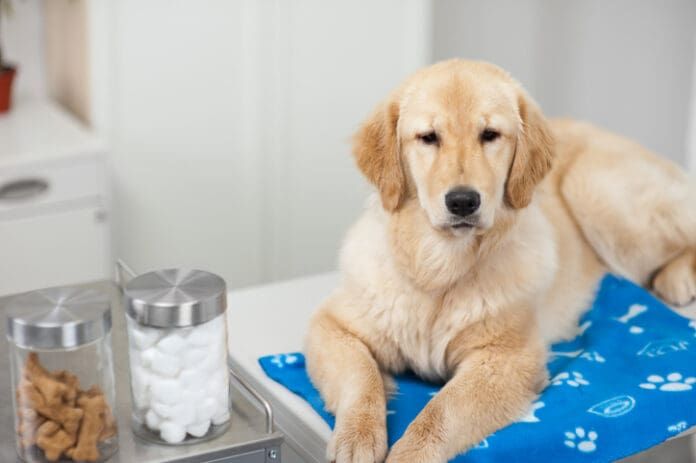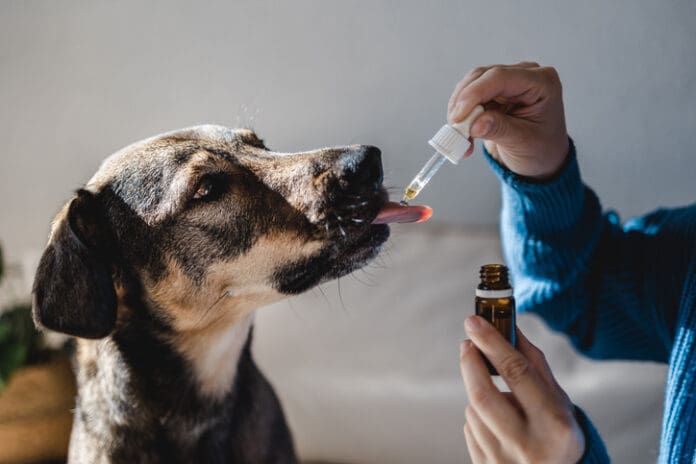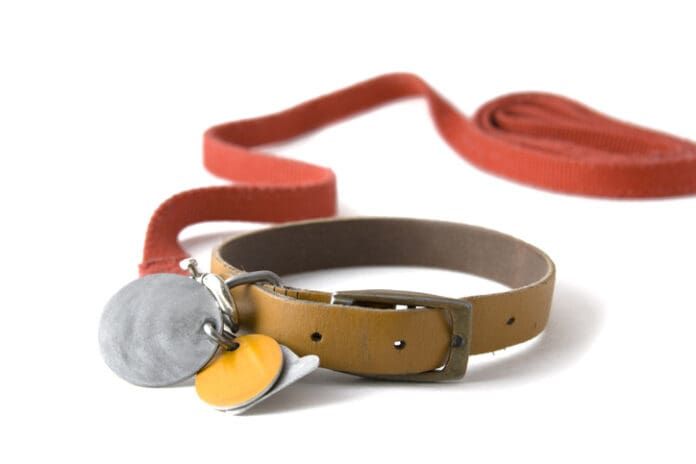According to Oquendo, one of the biggest mistakes people make when bathing their dog is “oversoaping.” Across the board, professional groomers stress that diluting shampoo before applying is the unqualified key to success. Because of its thickness, full-strength shampoo tends to cling to the top of the coat, resisting even distribution and not penetrating to the undercoat and skin beneath.
Oquendo pre-mixes her shampoo in an empty two-liter soda bottle: She adds about a half-inch of shampoo and then fills the rest with water. Making sure the dog is totally saturated before applying the shampoo is another must. “The wetter the dog, the more the shampoo will mix into the coat,” she says, adding that she starts at the top, with the dog’s back, and then works her way down the sides.
With most dogs, once it not enough: Reynolds says when groomers hand-wash their charges, they shampoo them twice. “Lots of times, on the first shampoo, you won’t get the coat as wet, and it won’t get wet through.”
And don’t forget a good-quality conditioner. “A lot of people think their dogs have allergies when actually the skin is dried out from washing,” Reynolds says. “I condition every dog I bathe — even the short-haired ones.” Dilute the conditioner just as you do the shampoo, and let it sit on the coat for a minute before rinsing.
MAKE SURE TO RINSE VERY THOROUGHLY
That brings us to another important part of the bathing routine that many owners bungle. Residual soap in the coat can irritate the skin, leading to itchiness, flaking, hotspots, and other skin problems.
“Rinse, rinse, rinse,” says Stromberg.“You need to rinse until you don’t see any more suds.” Then, after you think you’re done, “rinse for another three minutes.” Just to be sure.
Many owners avoid washing their dogs’ faces, and that’s understandable: Shampoo that inadvertently gets into a dog’s eyes creates just as painful and burning a sensation as it does for we humans. “And you can actually cause ulcers to the eyes if you get shampoo in them and don’t rinse it out,” Reynolds says.
But the solution isn’t avoidance: It’s using the right technique and product. “I put my hand over the dog’s face and cover the eyes,” whenever washing or rinsing in that area, Oquendo says. “And I tilt the head downward so any soap will run down rather than sitting on top of the head.”
There are a variety of face washes that are specially developed for cleaning this part of a dog’s body. Reynolds recommends South Bark’s Blueberry Facial (southbark.com), which can also be used as a full-body shampoo.
BRUSHING UP
With a long-coated dog, the best time to brush and comb the hair is while it is still wet, not dry. “If you have a longer-coated dog that has more hair, like a Shih Tzu or a Goldendoodle, the best time to comb them out is when the hair is damp,” Reynolds says. “That’s when hair is flexible, and it’s easier to see where the tangles are.”
But if you haven’t been regularly brushing and combing your dog, don’t expect a bath to miraculously leave her looking like a Breck Girl. In fact, if you bathe a longhaired dog whose grooming has been neglected — Oquendo’s rule of thumb is that a dog with a coat more than an inch long should be groomed every day — you will be doing more harm than good. “It’s like washing a wool sweater,” Reynolds says. “It just causes the tangles to get even tighter.”
If your dog has an unkempt and possibly matted coat, immediately head to a professional groomer to have it taken care of. Do not attempt to yank or cut out the mats yourself: The aftermath just might land your dog at the vet’s office. Oquendo reminds that brushing and combing have different functions: The brush is the advance man, loosening up the coat to make it ready for the more narrowly spaced tines of the comb. If the comb begins to meet resistance, don’t try to force it through. Instead, return to the brush until you’ve made enough headway to start combing again. (Note that the tines on either end of the comb are spaced differently. At the start of your combing session, start with the wider end. As the coat gets smoother, switch to the narrower side.)
“Combing is really important,” Oquendo says. “And that means getting that comb right down to the skin. Otherwise, it’s just surface brushing, and if you part the coat, there are mats beneath.”
Not surprisingly, the quality of the brushes and combs you use is very important. “Basically, the more you spend, the better the quality,” says Oquendo, who has paid as much as $85 for a comb. Cheap-quality brushes have tines that are simply cut, as opposed to rounded, and will scratch the skin.
MANAGE YOUR OWN EXPECTATIONS
Get a bunch of dog groomers together for coffee, and chances are the talk invariably turns to the “Doodle” explosion among their clients. Their gripe isn’t with the dogs themselves: It’s with the owners who have selected a particular type of dog without understanding the grooming — and, often, temperament — issues that come with it.
“Doodles are one of the hardest dogs to wash because their coats are so dense,” Stromberg explains. Thanks to the designer dog’s mixed heritage — a Poodle typically crossed to a Labrador or Golden retriever — “you’re dealing with double, curly coats with undercoat. And with hyper dogs – a dog who has lost his patience by the time you’ve wetted him down.”
The kind of coat your dog has will help you determine how much bathing and grooming she needs, and what products will work best for her. And while there are general rules of thumb (“Nine times out of 10, a German Shepherd will shed more than an Afghan Hound, and a German Shorthaired Pointer will shed less than a Lab,” Stromberg says) there can be big variations among dogs of the same breed or type.
Bathing does cut down on shedding, but “some dogs will never stop shedding, even if you bathe them once a week,” Stromberg says. Of course, you love the dog you love. But if you decide to buy a purpose-bred dog, seek out a reputable breeder who pays attention to coat quality, especially in breeds with long or distinctive coats, such as terriers. Dogs with poorly textured coats are much more difficult to keep clean, bathe, groom, and maintain.
HOW DRY I AM
Once a dog is properly bathed, getting him dry is the next step. As you might expect, towels are a must — lots and lots of towels. “Absorb as much as you can after you’ve rinsed your dog well,” Reynolds advises. “The more moisture you absorb with the towel, the faster they dry.” Consider investing in a drying towel, which has an absorbent, deep-pile surface that wicks water away from your dog’s coat, like a shammy cloth.
A good toweling and brisk romp through the backyard (weather permitting, of course) is likely all a short-coated dog needs to get dry. But dogs with double coats, such as Akitas or Samoyeds, will certainly require extra help. “Undercoat is designed to insulate, and when that insulation is not needed, it comes out — all over your house,” Reynolds explains. When professional groomers dry double-coated dogs, they use dog-specific dryers that blast room-temperature air at such high velocity that the downy undercoat is loosened and pushed out. That, in turn, significantly reduces the amount of shedding — those tumbleweed-like tufts that can turn your living room into a convincing approximation of an Arizona ghost town.
Drying a dog with a hand-held blow dryer takes a lot of time (especially if you use the lowest possible setting to prevent unintentionally burning or overheating the dog), and it does nothing to remove the undercoat. While high-velocity dryers are available to non-professionals, they require skill and experience to operate safely.
“They can be really dangerous in the wrong hands,” Reynolds warns. “You could literally blow a Yorkie across the room with one.” If not placed properly, high-velocity dryers “can pop an eardrum or even a lung,” she adds. “They are great equipment, if someone takes the time to learn how to use them properly.” You should never use a high-velocity dryer around the head, and using a product like a Happy Hoodie (see happyhoodie.com) is a good idea: It not only safely covers the ears, but it also applies calming pressure, because force-drying is very often a stressful experience for a dog, especially one who is new to it.
Some owners might decide that all this bother isn’t worth it, and so they opt to shave a dog like a Golden Retriever to eliminate the problem. But this also has its quandaries. “The mechanics of a double coat are that the undercoat keeps the dog cooler in summer and warmer in winter,” Reynolds explains. “When you shave off that double coat, you’re also removing the dog’s means of regulating his body temperature. Shaved dogs are more susceptible to bug bites and sunburn, and shaving off the top coat will make the undercoat shed more.” As a result, Reynolds rarely recommends shaving, except when a dog is severely matted.
To learn more about the importance of bathing your dog, download Whole Dog Journal’s ebook Healthy Skin & Coat.







